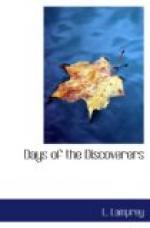“I have no doubt she did, and that is why it flourishes from Easter to Michaelmas. But I came to-day for a potato. Sieur de Monts desires to see one and to understand the method of its cultivation.”
“Oh, I know that,” cried Helene, eagerly, and she took one of the queer brown roots from the willow basket by the wall. “See, these are its eyes, one, two, three—seven eyes in this one. You must cut it in pieces, as many pieces as it has eyes, and plant each piece separately; and from each eye springs a plant.”
“Ah!” said Lescarbot gravely, and he put the potato in his wallet.
For two years Pierre du Guast, Sieur de Monts, and the valiant gentlemen Samuel de Champlain, Bienville de Poutrincourt, and others of his company, had been striving to maintain a settlement in the grant of La Cadie or L’Acadie, between the fortieth and forty-sixth degrees of north latitude in the New World, of which the King had made De Monts Lieutenant-General. De Monts engaged Champlain, who had already explored those coasts, as chief geographer, and the merchant Pontgrave was in charge of a store-ship laden with supplies. Fearing the severe winter of the St. Lawrence, the party steered south along the coast and anchored in a tranquil and beautiful harbor surrounded with forest, green lowlands, and hills laced with waterfalls. In his delight with the place Poutrincourt declared that he would ask nothing better than to make it his home; and he received a grant of the harbor, which he named Port Royal. The expedition finally came to rest on an island in a river flowing into Passamaquoddy Bay, where they began their settlement. Their wooden buildings—a house for their viceroy, one for Champlain and other gentlemen, barracks, lodgings, workshops and storehouses,—surrounded a square in the middle of which one fine cedar was left standing, while a belt of them remained to hedge the island from the north winds. The work done, Poutrincourt set sail for France, leaving seventy-nine men to spend the winter at Ile Sainte-Croix. Scurvy broke out, and before spring almost half the company were in their graves. Spring came, but no help from France. It was June 16 before Poutrincourt returned with forty men, and two days later Champlain set sail in a fifteen-ton barque with De Monts and several others, to explore the coast and discover if possible a better place for the colony. They went as far south as Nauset Harbor, and Champlain made charts and kept a journal quaintly illustrated with figures drawn and painted; but De Monts found no place that suited him. Then he bethought himself of the deep sheltered harbor of Port Royal, and they removed everything to that new site, on the north side of the basin below the mouth of a little river which they called the Equille. Even parts of the buildings were taken across the Bay of Fundy. But a ship from France brought news to De Monts that enemies at court were working against his Company, and leaving Pontgrave in command he and Poutrincourt




